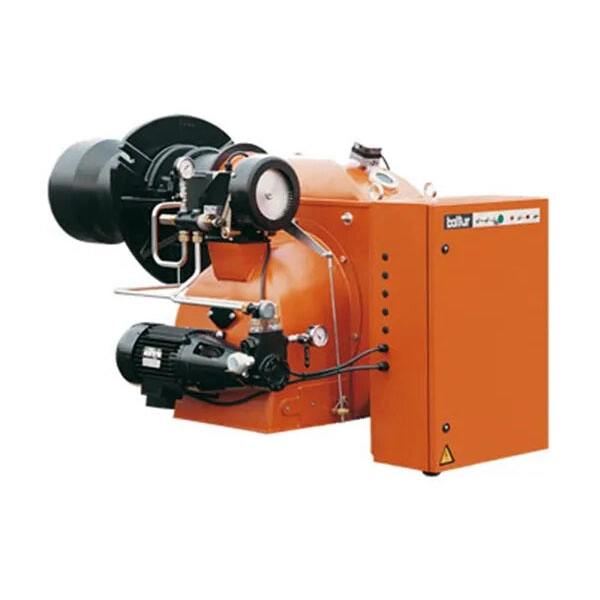
A two-stage heavy oil burner is an industrial combustion device designed to provide efficient and stable heat output by operating in two distinct firing stages: low fire and high fire. This staged combustion system allows the burner to adjust its heat release according to process requirements, improving fuel efficiency and reducing emissions.
A two-stage heavy oil burner is a sophisticated combustion device designed to efficiently burn heavy fuel oils, often used in industrial applications like boilers, furnaces, and heaters. The "two-stage" aspect refers to its operational strategy, where the combustion process is divided into two distinct phases to optimize efficiency, reduce emissions, and handle the challenging characteristics of heavy oils.
Heavy fuel oils, such as residual fuel oil (RFO) or Bunker C, are byproducts of crude oil refining. They are characterized by:
High Viscosity: They are very thick and don't flow easily at ambient temperatures.
High Flash Point: Requires significant preheating to atomize and ignite.
High Impurity Content: May contain sulfur, ash, and other contaminants that can lead to corrosion and emissions.
Lower Volatility: Not as readily ignitable as lighter fuels.
Fuel Supply System:
Storage Tanks: For storing heavy oil.
Pumps: To transfer oil from storage to the burner.
Heaters (Preheaters): Crucial for reducing the oil's viscosity to an atomizable state. This is typically achieved using steam or electric heaters.
Filters: To remove particulates that could clog nozzles.
Air Supply System:
Combustion Air Fan: Provides the necessary air for combustion.
Dampers: Control the amount of air entering the burner.
Air Register: Directs and swirls the combustion air for optimal mixing with the atomized fuel.
Atomization System:
Nozzle: The core component where heavy oil is transformed into a fine mist.
Atomizing Medium: This can be steam or compressed air, which is mixed with the preheated oil to create fine droplets, increasing the surface area for combustion.
Ignition System:
Igniter: Typically an electric spark igniter or a pilot burner (often fueled by lighter oil or gas) to initiate combustion.
Control System:
Flame Safeguard: Monitors the flame and shuts down the burner in case of flame failure for safety.
Modulating Controls: Adjust fuel and air flow based on demand.
Sensors: Temperature, pressure, and flow sensors to monitor operating conditions.
The "two-stage" aspect primarily relates to how the air and sometimes the fuel are introduced:
Stage 1 (Primary Combustion Zone):
Fuel and Partial Air: Preheated heavy oil is atomized and mixed with a limited amount of primary combustion air, often substoichiometric (less air than theoretically
required for complete combustion).
Partial Combustion: This creates a fuel-rich, high-temperature zone. The goal here is to vaporize the heavy hydrocarbons and initiate partial oxidation. This stage helps in "cracking" the larger hydrocarbon molecules into smaller, more combustible ones and reducing the formation of thermal NOx.
Stage 2 (Secondary Combustion Zone):
Introducing Secondary Air: Downstream from the primary zone, additional combustion air (secondary air) is introduced. This air completes the combustion process.
Complete Combustion: The remaining hydrocarbons and intermediate products from Stage 1 are fully oxidized, leading to complete and efficient combustion, maximizing heat release.
Benefits of Two-Stage Combustion:
Improved Combustion Efficiency: By progressively introducing air, the burner can achieve more complete burnout of heavy fuels, extracting maximum energy.
Reduced Emissions:
NOx Reduction: By creating a fuel-rich primary zone (low oxygen), the formation of thermal NOx is significantly reduced. The secondary air is then introduced in a way that avoids sharp temperature peaks, further limiting NOx.
Soot and Particulate Reduction: Better mixing and complete combustion minimize unburnt carbon particles.
Enhanced Stability: The staged air introduction can lead to a more stable flame, especially with varying fuel quality.
Flexibility: Can better handle the challenging properties of heavy fuel oils compared to single-stage burners.
Two-stage heavy oil burners are commonly found in:
Industrial boilers for steam generation
Power plants
Process heaters in refineries and chemical plants
Marine propulsion systems
Asphalt plants
In summary, a two-stage heavy oil burner is an engineered solution to efficiently and cleanly burn viscous, impurity-laden heavy fuel oils by carefully controlling the mixing of fuel and air in sequential stages, leading to economic and environmental benefits.
Take every customer request seriously.

Shuxin
Electromechanical
+86 15516359168
shuxin@sxburner.com
Room 504, Building 11, Wuzhou International Industrial Expo City, Old National Highway 310, Xigong District, Luoyang City, Henan Province
+86 15516359168
shuxin@sxburner.com
Room 504, Building 11, Wuzhou International Industrial Expo City, Old National Highway 310, Xigong District, Luoyang City, Henan Province